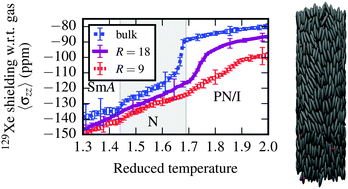Xenon NMR of liquid crystals confined to cylindrical nanocavities: a simulation study†
Abstract
Applications of liquid crystals (LCs), such as smart windows and the ubiquitous display devices, are based on controlling the orientational and translational order in a small volume of LC medium. Hence, understanding the effects of confinement to the liquid crystal phase behaviour is essential. The NMR shielding of 129Xe atoms dissolved in LCs constitutes a very sensitive probe to the details of LC environment. Linking the experimental results to microscopic phenomena calls for molecular simulations. In this work, the NMR shielding of atomic 129Xe dissolved in a uniaxial thermotropic LC confined to nanosized cylindrical cavities is computed from coarse-grained (CG) isobaric Monte Carlo (MC) simulations with a quantum-chemically (QC) pre-parameterised pairwise-additive model for the Xe nuclear shielding tensor. We report the results for the 129Xe nuclear shielding and its connection to the structure and order of the LC appropriate to two different cavity sizes, as well as a comparison to the results of bulk (non-confined) simulations. We find that the confinement changes the LC phase structure dramatically and gives rise to the coexistence of varying degrees of LC order, which is reflected in the Xe shielding. Furthermore, we qualitatively reproduce the behaviour of the mean 129Xe chemical shift with respect to temperature for atomic Xe dissolved in LC confined to controlled-pore glass materials. In the small-radius cavity the nematic – paranematic phase transition is revealed only by the anisotropic component of the 129Xe nuclear shielding. In the larger cavity, the nematic – paranematic – isotropic transition is clearly seen in the Xe shielding. The simulated 129Xe NMR shielding is insensitive to the smectic-A – nematic transition, since in the smectic-A phase, the Xe atoms largely occupy the imperfect layer structure near the cavity walls. The direct contribution of the cavity wall to 129Xe nuclear shielding is dependent on the cavity size but independent of temperature. Our results show that the combination of CG simulations and a QC pre-parameterised 129Xe NMR shielding allows efficient studies of the phase behaviour and structure of complex systems containing thousands of molecules, and brings us closer to the simulation of NMR experiments.


 Please wait while we load your content...
Please wait while we load your content...